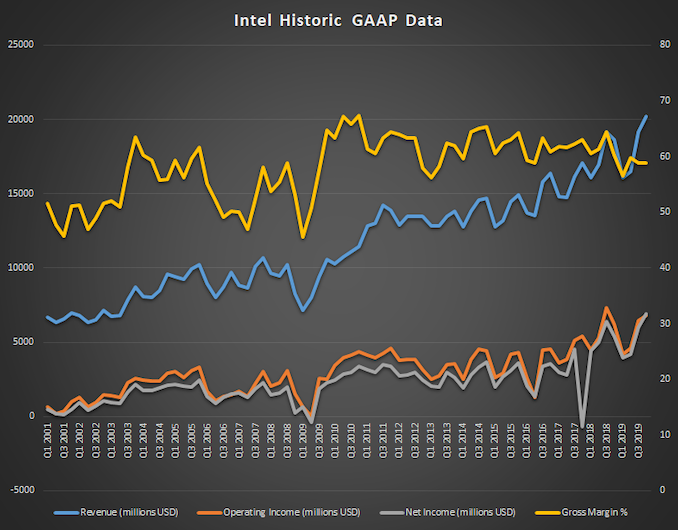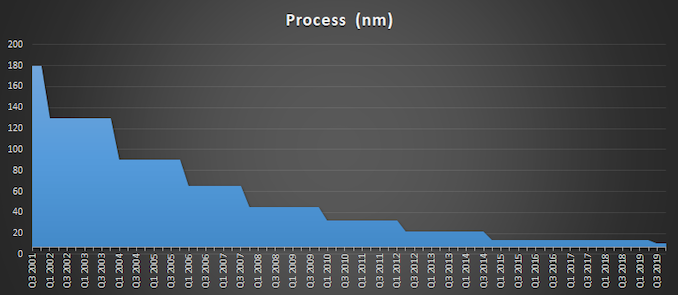Intel Q4 FY 2019 Results: Record Quarter, Record Year
by Brett Howse on January 23, 2020 8:45 PM EST- Posted in
- CPUs
- Intel
- Financial Results

Today Intel announced their earnings for the fourth quarter of their 2019 fiscal year. In terms of revenue, Intel had their highest ever Q4 revenue, coming in at $20.2 billion, and the full 2019 fiscal year, which was $72 billion. On a year-over-year basis, the results were up 8% and 2% respectively. Intel’s margins did slip a bit though, falling 1.4% to 58.8% of revenue. Operating income for the quarter was $6.8 billion, up 9% from last year, and net income was up 33% to $6.9 billion. This resulted in earnings-per-share of $1.58, up 40% from a year ago.
| Intel Q4 2019 Financial Results (GAAP) | |||||
| Q4'2019 | Q3'2019 | Q4'2018 | |||
| Revenue | $20.2B | $19.2B | $18.7B | ||
| Operating Income | $6.8B | $6.4B | $6.2B | ||
| Net Income | $6.9B | $6.0B | $5.2B | ||
| Gross Margin | 58.8% | 58.9% | 60.2% | ||
| Client Computing Group Revenue | $10.0B | +3% | +2% | ||
| Data Center Group Revenue | $7.2B | +12% | +19% | ||
| Internet of Things Revenue | $1.16B | +16% | +16% | ||
| Mobileye Revenue | $229M | +14% | +20% | ||
| Non-Volatile Memory Solutions Group | $1.2B | -7.7% | +10% | ||
| Programmable Solutions Group | $505M | flat | -17% | ||
Intel’s Client Computing Group, or CCG, had revenues of $10.0 billion for the quarter, up 2% from a year ago. Intel attributes the growth to modem sales and desktop platform volume. Intel is of course moving out of the 5G modem business, but will maintain its other connectivity offerings in the CCG such as their Wi-Fi products. Notebook platform volumes were down 1% in this quarter, with average selling prices staying flat, but desktop platform volumes were up 7%, but average selling prices fell 4%. Intel has said that they are expecting their chip shortage to be over by the end of this fiscal year.
Intel’s Data Center Group had revenue of $7.2 billion, up 19% from a year ago. Data Center sold 12% more unit volume this quarter than Q4 2018, and also added in 5% more average selling price per unit, so Intel’s DCG group is still very healthy.
Internet of Things, which include Mobileye, achieved revenue of $1.16 billion, up from $999 million a year ago. IoT was up 13%, accounting for $920 million of that revenue, and Mobileye was up 31% to $240 million.
Non-volatile Storage had revenue of $1.2 billion for the quarter, up 10% from a year ago which Intel is attributing to both NAND and Optane bit growth.
Programable Storage was the one area where Intel had a revenue drop, falling 17% year-over-year to $505 million, with no explanation given, but clearly FPGAs were in shorter demand.
Looking ahead to Q1 2020, Intel is expecting approximately $19.0 billion in revenue for the quarter, with earnings-per-share of $1.23.
Source: Intel Investor Relations












67 Comments
View All Comments
Korguz - Friday, January 24, 2020 - link
part of it was TSMCs 7nm, and intel screwing up with its 10nm node. but who knows where cpus would really be if intel didnt spend the last 3 or 4 years screwing up. there is still a good cpu architecture in Zen. and why is intel using an architecture that is 9 YEARS OLD ? because they for LAZY. thats why... what did intel do for the cpu industry before zen ? NOTHING. they stagnated the cpu industry, stuck the mainstream at 4 CORES, and lets not forget how generous they were by giving us what was it, 10% or less performance increases year over year, while they kept increasing prices. thank you intel !!!! amd seems to be the one that innovates more then your beloved intel cicciob... so keep praising them, keep buying their over priced cpus...MarcusMo - Friday, January 24, 2020 - link
One of these days, someone is going to write a plug-in that looks for awkward capitalization and superfluous punctuation and just filter out these posts out. And the world will have lost nothing of value.CiccioB - Friday, January 24, 2020 - link
One of these days technical forums will introduce a simple preliminary test to pass to be able to post and suddenly many clueless posters will disappear with none regretting them.Korguz - Friday, January 24, 2020 - link
like you there cicciob ?? all you do is type intel biased fud do defend your beloved intel...CiccioB - Friday, January 24, 2020 - link
Dear AMD fan,it is not a question of praising a global company like Intel.
My Intel shares will go up and down independently of whatever say here.
So will do my AMD ones.
The one trying to praise a company (AMD) with moot reasons is you.
Intel was using a 9 old architecture simply because there was nothing better than it on the market.
The 10% performance increase is the same order of magnitude that AMD is bringing with Zen at its revisions. In fact once you have reached the maturity of an architecture you can but raise slowly its performance while spending lots of resources to do so. Or you can spare resources and gain more it.
AMD just filled the gap of 9 year old architecture. Just think about why they arrived now at par using what seems to be one of the best PP that TSMC has created up o now: they were so innovative fora these years? With which results? Stay behind 9 years with respect to the competition?
However, Zen is only decent, as it still has difficulties in overcoming that same 9 year old architecture that Intel has been happily selling for all these years despite a better PP.
Actually against Ice Lake, that still suffer Intel 10nm PP issues, Zen is still lagging.
AMD innovation before Zen leads it to completely abandon professional market both in CPU and GPU markets. Its product where so advanced that a 9 years old architecture today still wins in many markets. Its GPUs were so good that Nvidia has moved selling x60 mainstream GPU from 150 at Fermi time to 350 dollars Turing. And again AMD filled partially the gap with respect to the competitor using a better PP without which it would be 2 years behind.
I understand that after so many years of having hoped for a market change and see your preferred company coming out from the shit it has been all this time, you AMD fanboy are now happy to see this somewhat happen. But that does not change the reality and the real reasons we are at this point: AMD did a decent job with Zen while Intel completely messes up with 10nm.
Moreover all that praising about multi billion company laziness and such statements which belong more to infantry school than to a technical forum like this, just show that you just are ignorant about how public quoted companies work and what are their aims.
Guess what? AMD tries to make the same that Intel does hoping to have the same or even better position with a better economical balance sheet than it has now. This year better than the previous, next one better than this.
Shortly: multi-billion quoted companies wants to increase their income, and they do that the better they can. Innovation, new products, selling prices including discounts and margins, are all weapons to be used for that. Some companies have to use some of them, other companies other weapons depending on their strength, capacity, skill and position.
Just guess why Intel has a gross margin of 58.8 while AMD is below 40%.
In your childish thoughts, do you just believe that it is because AMD is less greedy than Intel?
Or just because they can't charge as much? And do you think they won't charge as much is Intel position?
Korguz - Friday, January 24, 2020 - link
bla bla bla bla... keep trying to justify intels screw ups.. lazyness and market stagnation. sticking the mainstrean at quad core when they could of offered more cores... while over charging for minimal performace increases.. you are so intel biased is not funny...wilsonkf - Monday, January 27, 2020 - link
Zen is out for 3 years. Intel should have done something big, not keep pushing the same arch on 14nm+++ only adding 2 more cores and skyrocket the real TDP - for which they have to change socket to supply more current.Or at least they should work for a winter release. At least we need a heater in winter.
Beaver M. - Friday, January 24, 2020 - link
Coulda woulda shouldaIntel messed this up. They werent prepared for competition at all.
They still pressed overpriced 4-core desktop CPUs onto us just a few years ago, with no plans going anywhere beyond that, even though everyone begged them on their knees. Ryzen comes out and bam, Intel gives us 6, 8 and now 10 cores, and even lowers prices massively.
They were completely dumbfounded, so much that they cant even get their security flaws issue under control or even give proper information about when they will be fixed. Not to mention still being on 14 nm. Thats a laugh.
And as already said, Intel is much bigger than AMD. They should have been able to cope with that easily. But they didnt.
Intel is still far away from getting anything like AMD has right now. 7 nm will still take at least until 2023 or longer. And even 10 nm is still a year away.
The Skylake architecture is less than 5 years old. Still far too old for a company like Intel, if thats what you were trying to say........
HStewart - Friday, January 24, 2020 - link
I have not sure how much Keller actually contributed to the new Intel architectures. it take years for a new architecture to go into place and we only seen the blip of it with some laptops in U series.It odd how time repeats itself, before the i series came out we had Pentium 4 and AMD got ahead with new memory architecture and 64 bit, and for years Intel look unbeatable and no doubt the 10nm production has hit Intel hard but thankfully those days are over with.
But we need to be honest, how much more we need - especially in cores and where is the primary market. Gamer and 3d graphics markers seems to drive technology but they are not average consumer.
Korguz - Friday, January 24, 2020 - link
and then thers is hstewarts intel bias.." we only seen the blip of it with some laptops in U series. " this is NOT a new architecture. this is the same one they have been pushing for the last few years.. is it was new.. it would be gen 1.. NOT 10, come on hstewart.. is your intel bias that bad ??
" thankfully those days are over with " it is ??? BS
you only say that because intel is behind on this.. you still believe intels bs that mainstream only needs 4 cores dont you ??? and all the other bs intel has fed and lied about as well...